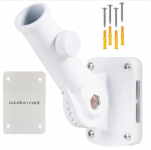A CB ground plane base station antenna works well and is relatively inexpensive. If you're only using the antenna for your scanner, simply shorten the radial and radiators by a foot or so to get you in the middle of the 30-50 MHz band. Ground the antenna and using lightning protection devices as well as quality coaxial cable.
The low hanging fruit is going to be the California Highway Patrol using just about every police frequency from 39 to 45 MHz. They're everywhere and are very active.
Check out the 33 MHz fire frequencies, too. There are still a bunch of east coast and New England area fire departments rocking this band, although many of them simply plug their UHF repeater or trunked system into the low band base station. If you consistently hear the mobiles at the same signal strength as the base along with that telltale repeater hang time, that's what you snagged.
44.58 MHz is a good beacon with railroad signalling equipment.
Once you get into the hobby, the real fun is looking other places for the rare gems. There are still some business band users around 30-31 MHz and again on 35 MHz.
35.04 and 43.04 MHz are for itinerant business band operation -- meaning not at any fixed location. Statewide or nationwide licenses can be found here, along with people operating on expired licenses and those who never bothered to get a license in the first place.
There are still some power companies and water districts using 37.46 to 37.86 MHz and 47.70 to 48.54 MHz for communication.
You might hear the Red Cross on 47.42 MHz in a disaster somewhere.
29.60 MHz and 52.525 MHz are the Amateur Radio calling frequencies for 10 meters and 6 meters, respectively. They are fun to hear when the band opens and are good indicators about the condition of skip-land.
42.96 and 43.00 MHz are very old business band channels that had an unusually high number of users back in the day. You might find someone still there with or without a current FCC license.
35.04 and 43.04 MHz are for itinerant business band operation -- meaning not at any fixed location. Statewide or nationwide licenses can be found here, along with people operating on expired licenses and those who never bothered to get a license in the first place.
And finally, don't forget 25.02 to 26.80 MHz -- the LOW low band. This is below the CB radio band and contains petroleum suppliers, offshore oil rigs, remote broadcast pickup transmitters, and who know what else.
With a good antenna system and some patience, low band can still be an adventure. Have fun!


